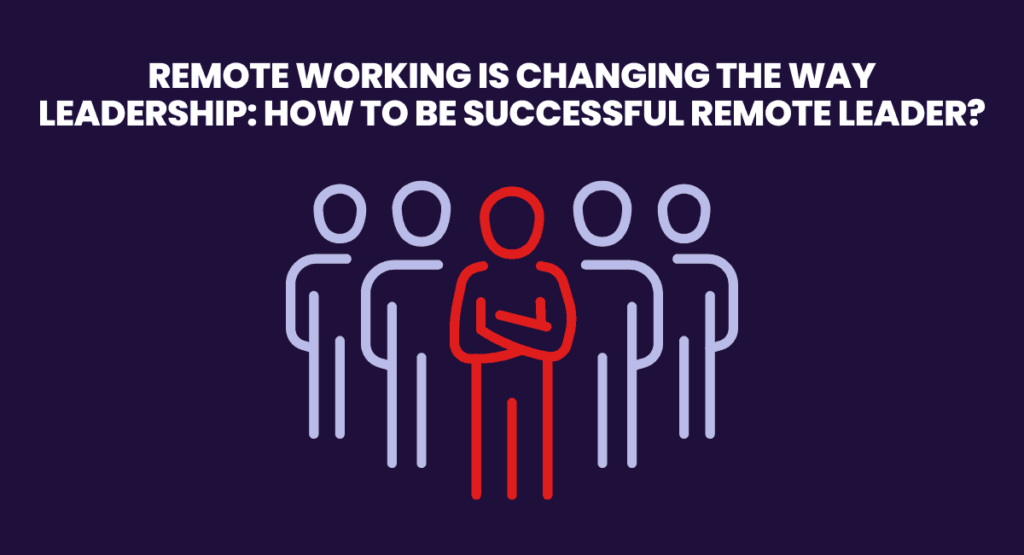How Remote Working is Changing the Way Leadership


How we work is changing, which means how leadership works are also changing.
The rise of remote working has created new challenges for leaders, from managing teams across different timezones to fostering connections between colleagues who might never meet.
But it’s not all bad news! The shift towards remote work can also present exciting opportunities for leaders to create more effective and efficient workplaces – if they know how.
In this article, we’ll explore how remote working is transforming the way leadership functions today and learn what you need to do as a leader to ensure your team succeeds in this brave new world.
So let’s get started!
The Impact of Remote Working on Leadership
“Without strong emotional bonds, distributed teams can suffer from low cohesion and loyalty.” Mercer USA.
Remote working is changing how we think about leadership.
It means that leaders need to be able to manage their teams from a distance and find ways for everyone to stay connected even when they’re not in the same room or office.
A remote leader requires new skills like good communication, trust, and creativity.
How we lead our teams are changing as remote working becomes more common, and it’s up to us as leaders to ensure that everyone is still able to work effectively despite the physical distance.
Leading remote teams also means that leaders must be flexible and adaptable, as different people have different working styles and preferences.
The way you lead one team won’t necessarily work for another, so it’s essential to understand what works best for each individual and how they prefer to communicate.
Leaders must also find ways to motivate their teams in a remote environment and stay connected to their colleagues to ensure a healthy workplace culture.
Fostering a Positive Remote Working Environment

Leaders need to be aware of the unique challenges of remote work, such as feeling isolated or disconnected from the team.
Remote leaders need to foster a positive and inclusive working remote environment proactively.
This can include creating an open and supportive culture where everyone’s voices are heard and valued and providing the right tools and support to ensure that team members feel connected even when they are not face-to-face.
Remote leaders should also be clear about expectations for remote work.
This could include setting clear boundaries for when work starts and ends, having regular check-ins with the team, and ensuring everyone knows their responsibilities.
Businesses should communicate these expectations from the start to help ensure that everyone feels supported.
Finally, leaders must focus on creating a sense of community and building strong relationships, which can help combat loneliness for remote workers.
The Benefits of Remote Leadership for Organizations

The benefits of this type of leadership include being able to work from anywhere, increasing productivity, and reducing costs.
Remote leaders can work without being in an office, saving time and money on travel expenses. They can also access more resources and collaborate with a global network of professionals.
The result is increased efficiency, better communication between team members, and greater employee flexibility.
The ability to work from anywhere also allows for greater collaboration, which can lead to increased creativity and innovation.
Remote leaders have more control over their work environment, allowing them to create a space that works best for themselves and their team.
The freedom of working remotely has increased engagement, productivity, job satisfaction, and well-being among employees.
The increased flexibility and autonomy given to remote workers help them balance their personal and professional lives, which can result in better mental health.
Remote leadership encourages remote organizations to prioritize employee development, as leaders can easily access various online training opportunities. This enables them to stay updated on the latest trends and technology, giving them an edge over their competition.
Overall, the benefits of remote leadership are numerous and can significantly improve an organization’s performance.
The key is balancing structure and flexibility, allowing teams to take advantage of the opportunities created by remote working while still adhering to the basic principles of effective leadership.
The Challenges Faced by Remote Leaders

Leaders who work remotely face some unique challenges.
The way leadership has changed because of remote working means that the traditional leading methods may no longer be effective in this new environment.
The biggest challenge for remote leaders is managing teams differently than they are used to, as people are not physically together and need to communicate differently.
They must also find ways to motivate their team members while maintaining a sense of unity and togetherness despite being apart.
Remote leaders need support to stay on track and complete their tasks on time without regular face-to-face contact with team members.
Lastly, remote leaders need to be able to trust their team members more than they would if the team was physically together, as there is less visibility into what everyone is doing on a day-to-day basis.
Essential Skills for Effective Remote Leadership
Essential skills for effective remote leadership can help people lead from a distance.
Leadership is changing by allowing people to work from home and still lead their teams. Leaders must have remote leadership skills to be successful in this virtual environment.
One important skill is understanding people’s emotions without seeing them in person.
Leaders need to be able to read between the lines of emails, texts, and video calls to know how someone feels about an issue or decision.
Another essential skill is trusting your team members even though you can’t be there with them all the time.
This means not micromanaging and giving employees responsibility for their tasks while providing guidance when needed.
Lastly, leaders need creativity when engaging with their remote employees, as it’s harder for everyone involved when working apart instead of together in an office setting.
The leader must develop remote leadership styles for everyone on the team to stay connected despite being spread out geographically.
These include regular check-ins and conversations about more than just work-related topics like hobbies or family life.
Get more out of your business
Get the best employee engagement content every week via mailing list
Remarkable Remote Leadership Strategies for Engaging and Motivating a Remote Team

The new strategies for remote leadership include finding ways to engage and motivate a team from afar.
The first strategy is to keep communication open and consistent. This means ensuring that everyone on the team knows their responsibilities, when tasks are due, and any other important information about the project.
The second strategy is creating remote collaboration environments by setting up productive virtual meetings or group chats to discuss ideas.
The third strategy is to provide incentives that reward your remote team members for their hard work and dedication, such as bonuses or extra vacation days.
These strategies can help ensure that your remote team has a successful experience while working together from home.
The Future of Remote Leadership in the Digital Age

The Future of Remote Leadership in the Digital Age is changing how people lead.
The digital age has made it easier for leaders to work remotely, meaning they don’t have to be at a specific place or location to do their job.
This allows them more freedom and flexibility in managing their employees and teams.
Remote working also gives leaders access to a larger pool of talent since they can hire from all over the world without worrying about an employee’s physical location.
Remote leadership requires different skills than traditional leadership as well.
Leaders must now be able to communicate more effectively with their team members and understand how technology works to get the most out of it.
Leaders also need good problem-solving skills since some issues may require quick decision-making or creative solutions that can only be done online or by phone.
The future of remote leadership looks bright, with many companies already seeing success from implementing this type of management style.
The rise in technology has allowed companies and employees alike more options and freedom regarding how they want their workplace environment set up; whether that means working from home or traveling for business meetings, remote working is here.
The Importance of Adapting to the New Normal for Business Success

Leaders need to adjust to the new way of working remotely for businesses to be successful. The modern workplace looks very different than it used to; now, many people don’t have an office and work from home or another location.
This has changed how leadership works; leaders must now figure out how to manage people remotely and motivate them without being physically present.
Another important part of adapting is technology. Technology can help keep teams connected even when they are not physically together.
Leaders should look into using tools such as video conferencing or online chat programs so their teams can stay in touch with each other regardless of location.
The last part of adapting is ensuring everyone understands their roles and responsibilities while working remotely.
Leaders need to communicate expectations, deadlines, and goals so that everyone involved in the business understands what is necessary to succeed.
Tips for Creating Trust Amongst Your Team Members When Managing Them Remotely

One crucial part of managing a remote team is creating trust among members.
To create trust, leaders must be honest and open with their team, and everyone must know what factors went into making the chosen decision.
Leaders should also check in regularly with each team member to find out how they are doing, what help they need, and if there is anything the leader can do to support them better.
Finally, leaders need to show appreciation for the hard work that the team does, even when working from home can be lonely or difficult sometimes.
The more recognition and rewards a leader gives out, the more likely their team will stay loyal and motivated over time!
Investing in Remote Leadership Training and Development Programs

Investing in leadership training and development programs for remote working is a crucial way to help leaders become better remote leaders.
Remote work involves people doing their jobs from a location other than the office. These training and development programs aim to help leaders understand how to manage teams that are not all in the same place.
The programs provide the following:
- Information about effective communication between team members.
- Setting team goals.
- Motivating employees.
- Using remote tools.
- Adapting when things change quickly.
Remote working has changed leadership because it requires different skills than leading a physical team in an office setting.
The leader must communicate with each person effectively while keeping everyone on task.
Leaders must also be able to trust their teams without being able to monitor them all the time physically.
The right training and development can help managers gain these skills to lead their teams successfully even when they are not together in one place.
Leaders who invest in remote leadership training and development will have more confidence in leading distributed teams since they will know what strategies work best for this environment.
It will also be better to have remote tools needed to make managing people easier, geographically or digitally speaking.
Frequently Ask Questions
Can I still be effective as a remote leader if I don’t have regular face-to-face interaction with my team members?

Yes, even without regular face-to-face interaction, it is possible to be an effective remote leader.
The key is creating a space for open communication between you and your team members through virtual meetings, emails, and other digital tools that allow collaboration.
You should also focus on setting expectations that ensure productivity and developing strong relationships with each team member.
With the right remote leadership skills, you can still positively impact your team despite working remotely.
What tools do you need to be a successful remote leader?
You need tools like video conferencing to help keep in touch with your team. Task management systems to assign tasks and track progress.
Communication platforms that allow for the easy sharing of ideas and information and software or apps that enable you to monitor employee productivity.
The key has the right tools to manage projects better remotely. With the right tools, remote working can be just as efficient as traditional leadership models.
How do I ensure my team can effectively communicate with me when I’m in a different city than them?

The best way to ensure effective communication with a team in a different city is to take advantage of digital technologies like video conferencing, chat applications, and email.
These allow people to collaborate over long distances and allow leaders to stay connected with their teams.
It’s also important for leaders to set up regular check-ins and be clear about expectations so everyone can work together effectively, even from different locations.
Conclusion
The landscape of work is changing rapidly. To be a successful remote leader, you must have the right skills.
With the right skills, you can build trust, motivate your team, and create a high-performing culture–all from afar.
Being a successful remote leader is not easy.
It takes training, understanding, and execution to get it right. But with the proper tools, you can be an excellent leader from anywhere in the world.
And as more companies move toward remote work models, your skills will only become more valuable.


